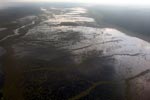
A cow stands in Brazil’s Pantanal, the world’s largest wetland which is threatened by cattle ranching and agriculture. In 2006 it was announced that 17 percent of the Pantanal had been lost to deforestation. Photo by: Rhett A. Butler.
Half of the worlds wetlands have been destroyed in just the last 100 years, says a new report. Published by the Economics of Ecosystems and Biodiversity (TEEB), the report found that of the 25 million square kilometers of wetlands that existed in 1900 just 12.8 million square kilometers now remain. The rate of destruction varies geographically with notable loses in East Asia running at 1.6 per cent per year. In places where aquaculture, over-exploitation (e.g. unsustainable harvesting of fish) and storm damage have been severe, the rate of destruction can be as high as 80 percent.
“There is an urgent need to put wetlands and water-related ecosystem services at the heart of water management in order to meet the social, economic and environmental needs of a global population predicted to reach 9 billion by 2050,” said Achim Steiner, UN Under-Secretary General and UN Environment Programme Executive Director, in a press statement.
Wetlands play a key role in supporting human life. They help regulate the water cycle, act as carbon sinks, offer protection from floods and storms, regulate sediment transport and contribute to land formation and coastal stability.
Wetlands also deliver a range of services and benefits much more cheaply than man-made infrastructure. In the United Kingdom for example, wetlands have been found to make cost savings of up to £0.71 million per hectare in terms of sea defense. In the United States, the Mississippi River Delta provides at least $12-47 billion in benefits to people every year in terms of hurricane and flood protection, water quality improvements and recreation.
As some of the world’s most biodiverse areas, wetlands supporting a quarter of global biological productivity. This high productivity means they are also an ideal setting for industry: ninety percent of the fish landed globally comes from coastal ecosystems, for example.
Yet, despite these startling statistics, wetlands continue to be degraded or lost altogether.
“Carrying on ‘business as usual’ is no longer an option,” said the Ramsar Convention’s Deputy Secretary General, Nick Davidson.
Wetlands and their wise use in water management must be put at the heart of the transition to a green economy, added the report, pushing the case for conservation of wetlands for human well-being.
“Given the current status and trends of wetland loss, this is the barest minimum that should be ensured by national governments…it is indeed true that it might not be just sufficient to manage the remaining world’s wetlands”, said Dr. Ritesh Kumar, Conservation Programme Manager at Wetlands International, and contributing author to the final report.
Whether we have the resources or political will to secure conservation and wise use of wetlands rests on creating awareness of their importance. The TEEB report goes a long away to achieving this goal.
Related articles
Mangrove deforestation 3x worse for climate than rainforest loss
(09/07/2012) Degradation and destruction of the world’s seagrasses, tidal marshes, and mangroves may generate up to a billion tons in carbon dioxide emissions annually, reports a new study.
Flooded savannas in Latin America shrinking 3 times faster than rainforests
(08/22/2012) Flooded grasslands and savannas in Latin America are disappearing nearly three times faster than tropical rainforests in the region, finds a new study published in the journal Biotropica.
Global wetlands shrink 6% in 15 years
(05/14/2012) Global wetlands declined by six percent between 1993 and 2007 due to conversion for agriculture, drainage, and water diversion, reports a new satellite-based assessment published by European researchers in Geophysical Research Letters.
Photos of the day: a celebration of wetlands (for World Wetlands Day)

(02/02/2012) Forget the groundhogs, February 2nd is also World Wetland Day, commemorating the historic convention of wetlands in Ramsar, Iran in 1971. The Ramsar Treaty was an international agreement meant to address the loss and degradation of wetlands worldwide.
Protecting original wetlands far preferable to restoration
(01/26/2012) Even after 100 years have passed a restored wetland may not reach the state of its former glory. A new study in the open access journal PLoS Biology finds that restored wetlands may take centuries to recover the biodiversity and carbon sequestration of original wetlands, if they ever do. The study questions laws, such as in the U.S., which allow the destruction of an original wetland so long as a similar wetland is restored elsewhere.